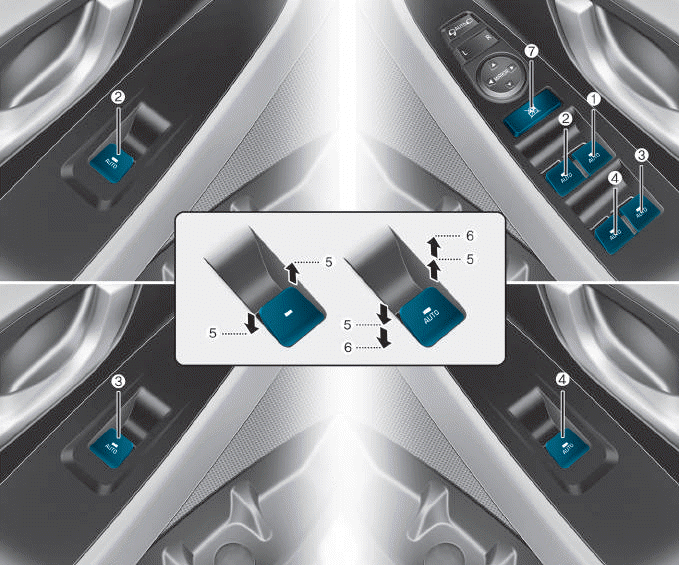Hyundai i-30: Ignition System / Spark Plug
Description and operation
| Description |
A spark plug is a device for delivering electric current from an ignition system
to the combustion chamber of a spark-ignition engine to ignite the compressed
fuel/air mixture therein by means of an electric spark, while containing combustion
pressure within the engine. A spark plug has a metal threaded shell, electrically
isolated from a central electrode by a porcelain insulator.

Specifications
| Specification |
|
Item |
Specification |
|
Type |
SILKR8J8GS |
|
Gap |
0.7 - 0.8 mm (0.0276 - 0.0315 in.) |
|
Electrode Material |
IRIDIUM |
Repair procedures
| Inspection |
[On vehicle inspection]
| 1. |
Accelerate the engine to about 3,000 rpm 3 times or more.
|
| 2. |
Remove the spark plug.
(Refer to Spark Plug - "Removal")
|
| 3. |
Check the spark plug visually.
If the electrode is dry, the spark plug is normal.
If the electrode is wet, check for damage and inspect the electrode
gap as follows.
|
[Component Inspection]
| 1. |
Check the spark plug for any damage on its thread and insulator.
If there is damage, replace the spark plug.
|
| 2. |
Check the electrode. Measure the insulation resistance with an ohmmeter.
If the resistance is less than the specified value, adjust the electrode
gap.
|
| 3. |
Check the spark plug electrode gap.
If the gap is greater than the maximum, replace the spark plug.
|
| Cleaning |
The combustion temporarily becomes unstable, due to the aged fuel and the carbon
deposits accumulated on the spark plug(s) after long-term storage.
[1st Method]
| 1. |
Start the engine and keep the engine running at idle for 2 minutes.
|
| 2. |
Step on the accelerator pedal and hold it steady at 4500 rpm with the
shift lever in N position to warm up the engine until the temperature
of the engine coolant reaches 80°C.
|
| 3. |
Keep the engine running at 2500 - 3000 rpm in the N position for 15
minutes.
|
[2nd Method]
|
| 1. |
Start the engine and keep the engine running at idle for 2 minutes.
|
| 2. |
Drive the vehicle for over 20 minutes, keeping the engine speed above
3500 rpm.
|
| Removal |
| 1. |
Remove the ignition coil.
(Refer to Engine Electrical System - "Ignition Coil")
|
| 2. |
Using a spark plug wrench, remove the spark plugs (A).
|
| Installation |
| 1. |
Install in the reverse order of removal.
|
 Ignition Coil
Ignition Coil
Description and operation
Description
The ignition coil is mounted on the top side of the cylinder head cover end.
The ignition coil consists of the primary coil that receives battery power and
the secondary coil that generates high voltage...
Other information:
Hyundai i30 (PD) 2018-2025 Service Manual: Lumber Support Units
Repair procedures Removal 1. Disconnect the negative (-) battery terminal. 2. Remove the front seat assembly. (Refer to Body - "Front Seat Assembly") 3...
Hyundai i30 (PD) 2018-2025 Owner's Manual: Engine compartment panel fuse replacement
■ Blade type fuse ■ Cartridge type fuse 1. Turn the vehicle off. 2. Turn all other switches OFF. 3. Remove the fuse panel cover by pressing the tap and pulling up. 4. Check the removed fuse; replace it if it is blown. To remove or insert the fuse, use the fuse puller in the engine compartment fuse panel...
Categories
- Manuals Home
- 3rd Generation i30 Owners Manual
- 3rd Generation i30 Service Manual
- Battery replacement
- LKA system operation
- Auto door lock/unlock features
- New on site
- Most important about car
Power windows

(1) Driver’s door power window
switch
(2) Front passenger’s door power
window switch
(3) Rear door (right) power window
switch
(4) Rear door (left) power window
switch
(5) Window opening and closing
(6) Automatic power window
(7) Power window lock switch
Copyright © 2025 www.hi30.net







